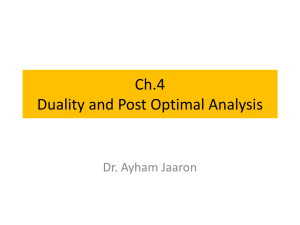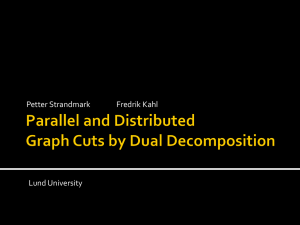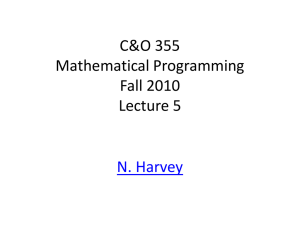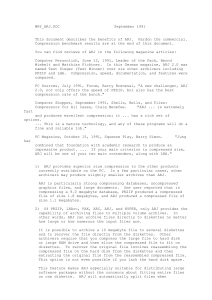Duality l. p
advertisement
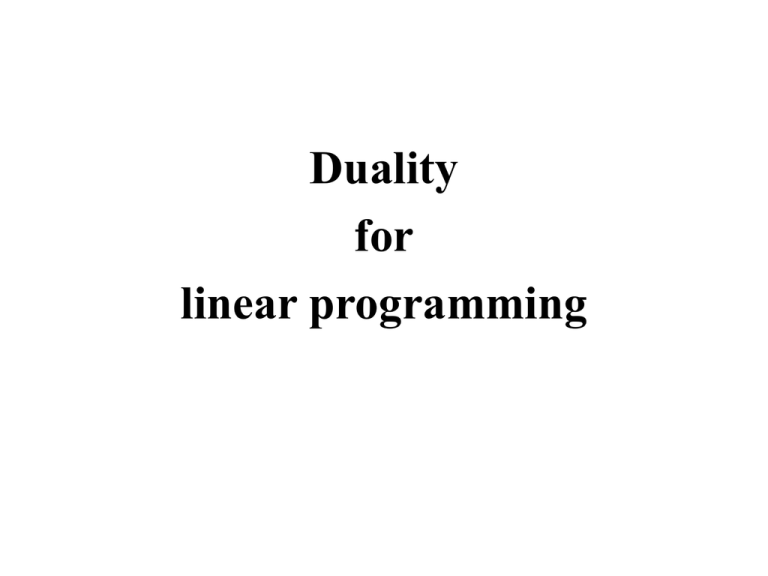
Duality for linear programming Illustration of the notion • Consider an enterprise producing r items: fk = demand for the item k =1,…, r using s components: hl = availability of the component l = 1,…, s • The enterprise can use any of the n process (activities): xj = level for using the process j = 1,…, n cj = the unit cost for using the process j = 1,…, n • The process j produces ekj units of the item k =1,…, r uses glj units of the component l = 1,…, s for each unit of its use Illustration of the notion • • Consider an enterprise producing r items: fk = demand for the item k =1,…, r using s components: hl = availability of the component l = 1,…, s The enterprise can use any of the n process (activities): xj = level for using the process j = 1,…, n cj = the unit cost for using the process j = 1,…, n • The enterprise problem: determine the level of each process for satisfying the without exceeding the availabilities in order to minimize the total production cost. • Model n min z c j x j j 1 n S. t. e j 1 • The process j produces ekj units of the item k =1,…, r uses glj units of the component l = 1,…, s each time it is used at level 1 kj n g j 1 lj x j fk k 1, 2,..., r (demands) x j hl l 1, 2,..., s (availabilities) xj 0 j 1, 2,..., n Illustration of the notion • A business man makes an offer to buy all the components and to sell the items required by the enterprise to satisfy the demands. • He must state proper unit prices (to be determined) to make the offer interesting for the enterprise: vk item unit price k = 1, 2, … , r wl component unit price l = 1, 2, …, s. n min z c j x j j 1 n S.t. e j 1 kj n g j 1 lj x j fk x j hl xj 0 k 1, 2,..., r (demands) l 1, 2,..., s (availabilities) j 1, 2,..., n vk wl Illustration of the notion The business man must state proper unit prices (to be determined) to make the offer interesting for the enterprise n min z c j x j j 1 n S. t e j 1 kj n To complete its analysis, the enterprise must verify that for each process j, the cost of making business with him is smaller or equal than using the process j. But the cost of making business with him is equal to the difference between buyng the items required and selling the components unused in order to simulate using one unit of process j (cj ). g j 1 lj x j fk x j hl k 1, 2,..., r (demands) l 1, 2,..., s (availabilities) xj 0 r j 1, 2,..., n s e v g w k 1 kj k buying the items l 1 lj l selling the components ≤ cj vk wl Illustration of the notion r s e v g w k 1 kj k lj l 1 buying the items l ≤ cj selling the components • The business man problem is to maximize his profit while maintaining the prices competitive for the enterprise r s k 1 l 1 r s max p f k vk hl wl S. t e k 1 v g lj wl c j kj k j 1, 2,..., n l 1 vk 0 k 1, 2,..., r wl 0 l 1, 2,..., s Illustration of the notion • The enterprise problem: multiply the availability constraints by -1 n min z c j x j j 1 ekj x j f k j 1 g j 1 n k 1, 2,..., rS.(demands) t. ekj x j f k k 1, 2,..., r (demands) j 1 n 1 min z c j x j j 1 n S. t. n lj x j hl xj 0 n l 1, 2,..., s (availabilities) glj x j hl l 1, 2,..., s (availabilities) j 1 j 1, 2,..., n xj 0 j 1, 2,..., n n E G Enterprise problem n min z c j x j r s j 1 n e S.t. kj j 1 x j fk e1 j k 1, 2,..., r (demands) ek1 n glj x j hl l 1, 2,..., s (availabilities) ek 2 ekj j 1 xj 0 j 1, 2,..., n erj g1 j Business man problem r s k 1 l 1 r s max p f k vk hl wl S. t. e k 1 v g lj wl c j kj k ekn j 1, 2,..., n l 1 vk 0 k 1, 2,..., r wl 0 l 1, 2,..., s gl1 gl 2 glj gln e1 j ekj erjg sj g1 j glj gsj E r T G s T n Primaln min z c j x j j 1 n e S. t. kj j 1 x j fk k 1, 2,..., r (demands) n glj x j hl l 1, 2,..., s (availabilities) j 1 xj 0 Dual s max p f k vk hl wl S. t. k 1 l 1 r s e k 1 w min c T x S. t. Ax b x0 j 1, 2,..., n r min z c T x S. t. E f x G h x0 v g lj wl c j kj k j 1, 2,..., n l 1 vk 0 k 1, 2,..., r wl 0 l 1, 2,..., s v max p f T h T w S. t. v E T G T c w v, w 0 x max bT y S. t. AT y c y0 Primal dual problems Linear programming problem specified with equalities Dual problem Primal problem T min c x S. t. Ax b x0 y max bT y S. t. AT y c y0 x Linear programming in standard form Primal problem min c T x S. t. Ax b x0 Dual problem y max bT y S. t. AT y c x min cT x S. t. Ax b x0 min c T x 0T s S. t. Ax Is b x 0, s 0 max bT y AT c S. t. T y 0 I max bT y S. t. AT y c Iy 0 max bT y S. t. AT y c y0 Duality theorems • It is easy to show that we can move from one pair of primal-dual problems to the other. • It is also easy to show that the dual of the dual problem is the primal problem. • Thus we are showing the duality theorems using the pair where the primal primal is in the standard form: primal Dual min c T x S. t. Ax b x0 max bT y S. t. AT y c Duality theorems • Weak duality theorem If x x : Ax b, x 0 (i.e., x is feasible for the primal problem) and if y y : AT y c (i.e., y is feasible for the dual problem), then bT y c T x T T T T Proof Indeed, b y x A y x c since AT y c and x 0. Duality theorems • Corollary If x * x : Ax b, x 0 and y y : A y c , and if bT y* cT x* , then x* and y* are optimal solutions for the primal and dual problems, respectively.. * T Proof It follows from the weak duality theorem that for any feasible solution x of the primal problem cT x bT y* cT x*. Consequently x* is an optimal solution of the primal problem. We can show the optimality of y* for the dual problem using a similar proof. Duality theorems • Strong duality theorem If one of the two primal or dual problem has a finite value optimal solution, then the other problem has the same property, and the optimal values of the two problems are equal. If one of the two problems is unbounded, then the feasible domain of the other problem is empty. Proof The second part of the theorem follows directly from the weak duality theorem. Indeed, suppose that the primal problem is unbounded below, and thus cTx→ – ∞. For contradiction, suppose that the dual problem is feasible. Then there would exist a solution y y : AT y c , and from the weak duality theoren, it would follow that bT y cT x ; i.e., bTy would be a lower bound for the value of the primal objective function cTx, a contradiction. Recall: The simplex multipliers Denote the vector R specified by Then m c T cT cBT B1 A T cBT B1 c T cT T A or c1, , cn c1, , cn T a1, c j c j T a j where a j denotes the jth column of the contraint matrix A , an is the simplex multipliers vector associated with the basis B. The vector has one element associated with each row (constraint) of the tableau. Duality theorems To prove the first part of the theorem, suppose that x* is an optimal solution of the primal problem with a value of z*. Let x j , x j ,..., x j be the basic variables. 1 2 m Let cB [c j1 , c j2 ,..., c jm ]T, and π be the simplex multipliers associated with the optimal basis. Recall that the relative costs of the variables are specified as follows c j c j T a j j 1, 2,..., n where a j denotes the jth column of the matrix A. Suppose that the basic optimal solution has the following property c j c j T a j 0 j 1, 2,..., n Consequently T a j c j j 1,2,..., n Duality theorems Suppose that the basic optimal solution has the following property c j c j T a j 0 j 1,2,..., n Consequently or T a j c j j 1,2,..., n aTj c j j 1,2,..., n and the matrix format of these relations: AT c This implies that y : AT y c i.e., π is a feasible solution of the dual problem. Duality theorems Determine the value of the dual objective function for the dual feasible solution π. Recall that B 1T cB . It follows that T T bT bT B1 cB (B1b)T cB xB* cB z* Consequently, it follows from the corollary of the weak duality theorem that π is an optimal solution of the dual problem, and that T b z* . Complementary slackness theory • We now introduce new necessary and sufficient conditions for a pair of feasible solutions of the primal and of the dual to be optimal for each of these problems. • Consider first the following pair of primal-dual problems. primal min c T x S. t. Ax b x0 Dual max bT y S. t. AT y c x Complementary slackness theory • Complementary slackness theorem 1 Let x and y be feasible solution for the primal and the dual, respectively. Then x and y are optimal solutions for these problems if and only if for all j = 1,2,…,n i ii xj 0 a y cj aTj y c j x j 0 T j min c T x S. t. Ax b x0 max bT y S. t. AT y c x Poof First we prove the sufficiency of the conditions. Assume that the conditions (i) et (ii) are satisfied for all j=1,2,…,n. Then x j [aTj y c j ] 0 n Hence j 1 x j aTj y c j 0 j 1, 2,..., n n x j aTj y x1aT1 x2aT2 j 1 Complementary slackness theory j 1, 2,..., x1n , x2 , x j [aTj y c j ] 0 n Hence j 1 x j aTj y c j 0 n But 0 j 1 x j a y c j Consequently T j aT1 T a , xn 2 y aT n x T AT y n xn aTn y n x a y T j j j 1 x j c j x T AT y c T x bT y c T x j 1 bT y c T x and the corollary of the weak duality theorem implies that x et y are optimal solutions for the primal and the dual problems, respectively. Complementary slackness theory Now we prove the necessity of the sonditions. Suppose that the solutions x et y are optimal solutions for the primal and the dual problems, respectively, and bT y c T x. Then referring to the first part of the theorem n j 1 x j a y c j Since T j n n x a y T j j j 1 x j c j xT AT y c T x bT y c T x 0 j 1 x j 0 et aTj y c j j 1, 2,..., n, it follows that x j aTj y c j 0 j 1, 2,..., n. The proof is completed. Complementary slackness theory • Now consider the other pair of primal-dual problems min c T x S. t. Ax b x0 y max bT y S. t. AT y c y0 x • Complementary slackness theorem 2 Let x and y be feasible solution for the primal and dual problems, recpectively. Then x and y are opyimal solutions of these problems if and only if for all j = 1,2,…,n for all i=1,2,…,m i ii xj 0 aTj y c j aTj y c j xj 0 iii iv ai x bi yi 0 yi 0 ai x bi Complementary slackness theory Proof This theorem is in fact a corollary of the complementary slackness theorem 1. Transform the primal problem into the standard form using the slack variables si , i=1,2,…,m: min c T x Sujet à Ax Is b x, s 0 min c T x S. t. Ax b x0 The dual of the primal problem in standard form max bT y S. t AT y c I y0 max bT y S. t. AT y c I y0 Complementary slackness theory Use the result in the preceding theorem to this pair of primal-dual problems min c T x S. t. Ax Is b x, s 0 max bT y S. t. AT y c I y0 y For j=1,2,…,n i ii xj 0 aTj y c j aTj y c j xj 0 yi 0 si 0 and for i=1,2,…,m iii si 0 iv yi 0 x s Complementary slackness theory For j=1,2,…,n i ii xj 0 aTj y c j aTj y c j xj 0 and for i=1,2,…,m iii si 0 iv yi 0 yi 0 si 0 But si ai x bi and then the conditions become iii iv ai x bi yi 0 yi 0 ai x bi min c T x S. t. Ax Is b x, s 0 Dual simplex algorithm • The dual simplex method is an iterative procedure to solve a linear programming problem in standard form. min z c1 x1 c2 x2 cn xn S. t. a11 x1 a12 x2 ... a1n xn b1 a21 x1 a22 x2 ... a2 n xn b2 . . . . . . . . am1 x1 am 2 x2 ... amn xn bm xj 0 j 1, 2,..., n Dual simplex algorithm • At each iteration, a basic infeasible solution of problem is available, except at the last iteration, for which the relative costs of all variables are non negatives. • Exemple min z 3/ 2u 1/ 2h 27 S. t. x 1/ 4u 1/ 4h 6 / 4 1/ 4u p 3/ 4h 15/ 2 y 1/12u 5/12h 13/ 2 x , y , u, p, h 0 basic var . r.h.s. Dual simplex algorithm Analyse one iteration of the dual simplex algorithm, and suppose that the current solution is as follows: basic var. r.h.s. c j 0 j 1,2,..., n c ji 0 i 1,2,..., m Leaving criterion basic var. c j 0 j 1,2,..., n r.h.s. If bi 0 i 1,2, , m, then the solution is feasible c ji 0 i 1,2,..., m and optimal. The algorithm stops. Leaving criterion basic var. c j 0 j 1,2,..., n c ji 0 i 1,2,..., m r.h.s. Otherwise, let br min bi . If arj 0 j 1, 2, i 1,2, ,m , n, then the feasible domain is empty. Indeed, since n for all x 0, arj x j 0 and j 1 it is not possible to find x 0 such that br n a j 1 rj x j = br . Leaving criterion basic var. r.h.s. c j 0 j 1,2,..., n c ji 0 i 1,2,..., m Otherwise, let let br min bi 0. x jr is the leaving variable. i 1,2, ,m The pivot will be completed with an element in the r th row. Leaving criterion basic var. r.h.s. c j 0 j 1,2,..., n c ji 0 i 1,2,..., m b1 a1s xs br ars xs bm ams xs We select the entering variable xs in such a way that 1) the value of the leaving variable x jr increases when the value of xs increases ii) the relativecosts of all the variables remains non negative when the pivot on ars is completed to modify a rs 0 the tableau. Leaving criterion basic var. r.h.s. ar1 ar 2 ars ars 1 ars 0 1 0 arn ars 0 br ars c j 0 j 1,2,..., n We select the entering variable xs in such a way that c ji 0 i 1,2,..., m a rs 0 cj arj ars cs 0, j 1,2, ,n 1) the value of the leaving variable x jr increases when the value of xs increases ii) the relative costs of all the variables remains non negative when the pivot on ars is completed to modify the tableau. Leaving criterion basic var. r.h.s. ar1 ar 2 ars ars 1 ars 0 1 0 arn ars 0 br ars c j 0 j 1,2,..., n c ji 0 i 1,2,..., m a rs 0 cj arj ars cs 0, j 1,2, ,n We select the entering variable xs in such a way that If avalue valuevariable of c j can only increase 1) the ofthen the the leaving xr increases when rj 0, since cs of0xand ars 0. the value s increases ii) the relative costs of all the variables remains non negative when the pivot on ars is completed to modify the tableau. Leaving criterion basic var. r.h.s. ar1 ar 2 ars ars 1 ars 0 1 0 arn ars 0 br ars c j 0 j 1,2,..., n We select the entering variable xs in such a way that For all 1) j such that aof 0, leaving we havevariable to inforce the non negativity the value the xr increases when rj c ji 0 i 1,2,..., m a rs of 0 the relative cost by properly the pivot element ars . the value of xselecting s increases cj arj ars cs 0, j 1,2, ,n ii) the relative costs of all the variables remains non negative when the pivot on ars is completed to modify the tableau. Entering criterion For all j such that arj 0, we have to inforce the non negativity of the relative cost; i.e., cj arj ars cs 0, j such that arj 0 cj cs 0, j such that arj 0 arj ars cj cs , j such that arj 0 arj ars Then the index s of the entering variable is such that cs cj max : arj 0 ars j 1,2, ,n arj or cs cj min : arj 0 j 1,2, , n ars arj Pivot • To obtain the simplex tableau associated with the new basis where the entering variable xs remplaces the leaving variable xr we complete the pivot on the element ars 0. Exemple basic var. r.h.s. • x is the leaving variable, and consequantly, the pivot is completed in the first row of the tableau • h is the entering variable, and consequently, the pivot is completed on the element -1/4 • After pivoting, the tableau becomes basic var. r.h.s. This feasible solution is optimal Convergence when the problem is non degenerate • Non degeneracy assumption: the relative costs of the non basic variables are positive at each iteration • Theorem: Consider a linear programming problem in standard form. min z c T x Subject to Ax b x0 c, x R n , b R m A m n matrix If the matrix A is of full rank, and if the non degeneracy assumption is verified, then the dual simplex algorithm terminates in a finite number of iterations. • Proof: Since the rank of matrix A is equal to m, then each basic feasible solution includes m basic variables strictly positive (non degeneracy assumption). But there is a finite number of ways to select m columns among the n columns of A to specify an m m sub matrix of A : n! n m m! (n m)! But the non feasible basis of A are a subset of these. Then n! n m m ! (n m)! is an upper bound on the number of non feasible basis of A. • The influence of pivoting on the objective function during an iteration of the simplex r.h.s. Deviding row r basic var. by ars → z br a rs cs Substact from br z z z cs z a rs since br 0, a rs 0, and c s 0 under the non degeneracy ass. br z z z cs z a rs since br 0, a rs 0, and c s 0 under the non degeneracy ass. Then z z, and the value of the objective function increases stricly at each iteration. Consequently, the same basic non feasible solution cannot repeat during the completion of the dual simplex algorithm. Since the number of basic non feasible solution is bounded, it follows that the dual simplex algorithm must be completed in a finite number of iterations. Comparing (primal) simplexe alg. and dual simplexe alg. Simplex alg. Dual simplex alg. Search in the feasible domain Search out of the feasible domain Search for an entering variable to reduce the value of the objective function Search for a leaving variable to eliminate a negative basic variable Search for a leaving variable preserving the feasibility of the new solution Search for an entering variable preserving the non negativity of the relative costs Stop when an optimal solution is found or when the problem is not bounded below Stop when the solution becomes feasible or when the problem is not feasible
